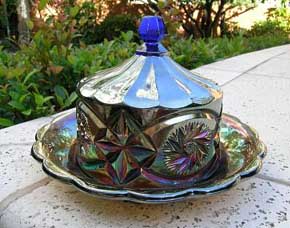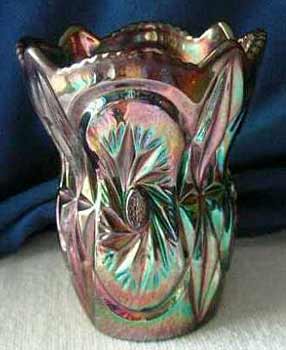[column-third-1]
 [/column-third-2][column-third-3]
[/column-third-2][column-third-3] [/column-third-3]
[/column-third-3]
This pattern is characterized by two dominant star patterns–an eight-pointed and a whirling star. Riihimaki is a Finish firm and this pattern is found in a 1939 catalog of their glasswares in a wide range of shapes. Above left is a rosebowl and to the right a spittoon shape. Unusual in that it appears to have been whimsied from a bowl–rare among European manufacturers.
In 2004, George Klawitter sent me the photo of a Starburst butter dish in blue (above right). Quite a find. He comments, as part of an article to appear in the Texas club newsletter:
The pattern on the butter dish I bought most nearly matches the pattern on the Starburst rose bowl with the interesting but necessary difference that the pattern had to be separated to accommodate the top and bottom of the butter dish. Thus on the butter top, just as on the rose bowl, there are eight figures: two whirling stars alternating with two eight-pointed stars, and in between these are four eight-pointed geometric figures. Oval miters outline the four stars. On the butter bottom (as on the rose bowl) is an eight-pointed star. The butter top and the outside of the bottom rim of the butter are fluted. The glass is a pale blue, except for the lid finial which is a rich cobalt blue, and the iridescence on the bottom interior is a radium wash of teal and pink, quite lovely. The iridescence on the lid is scant.
The base measures 7 1/2 inches across, and the whole butter dish stands five inches high. The interior cone of the base is curiously high–a full two inches–making a safe refuge for freshly churned butter. By contrast the interior lip in Northwood’s Grape and Cable butter is only 1/4 inch high and the lip in Imperial’s Hobstar butter is not much higher. Both of these latter dishes, however, do surround a well in which butter would rest. There is no such well in the Starburst butter, the two-inch core serving as a type of well. The Starburst lid could never shift off its base, unlike the Northwood and Imperial lids which are easily jiggled off their bases.
[column-half-1]Spittoons
Amber, 1,350 (2003), 375 (2007)
Amethyst, nip on tooth, 300 (2004)
Blue, 170 (2011)
Marigold, 225 (2010), 140 (2012), 130 (2014)[/column-half-1]
[column-half-2]Rosebowls
Blue, pinheads, 160 (2001)
Marigold, 65 (1995)[/column-half-2]
[column-half-1] [/column-half-1][column-half-2]
[/column-half-1][column-half-2] [/column-half-2]
[/column-half-2]
The little creamer on the left sold for $60 in 1994. The tumbler, 3 1/2 inches tall is in light blue and courtesy of Bob Smith. I have listings of two perfume bottles selling; one in 1998 for $105, another in 2002 for $195. A blue 5 1/2 inch plate with edge chips brought $50 in 1993.
[column-third-1]Water set, 7 piece
Blue, 500 (2004)[/column-third-1]
[column-third-2]Pitcher
Amber, 180 (2014)[/column-third-2]
[column-third-3]Tumblers
Amber, 125 (2005)
Marigold, 115, 170 (2004), 175 (2005), 35 (2008)[/column-third-3]
[column-half-1] [/column-half-1][column-half-2]
[/column-half-1][column-half-2] [/column-half-2]
[/column-half-2]
Vases are quite rare and found in at least two variations. The marigold on the left is 9 1/2 inches tall; the blue pinched-in version 5 1/4 inches tall. It sold on eBay in 2005 for $128 (with minor damage). A similar vase pattern is Starburst and Diamonds, also made by Riihimaki.
Vases
Amber, 5 inch, 275 (2007), 275 (2008), 115 (2015)
Blue, 10 inch, 350 (1999), 200 (2009)
Marigold, 5 inch, 240 (2007), 75 (2009)
Marigold, 10 1/2 inch, 300 (2000)
[pdb_list filter=’manufacturer=Riihimaki&pattern=Starburst’ sort=true orderby=”shape,color,saledate,price” order=”asc,asc,desc,asc”]
